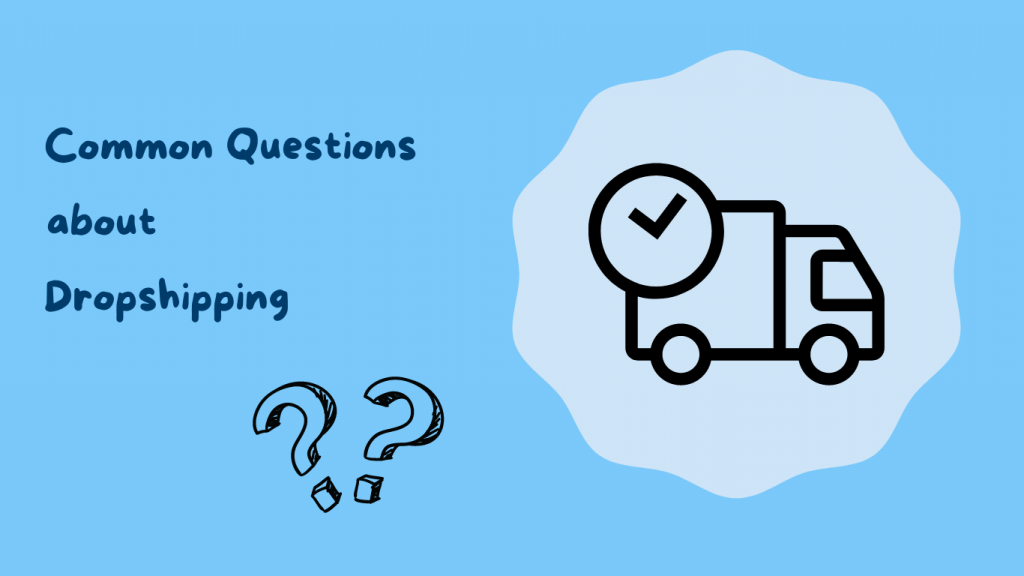Dropshipping is a popular fulfillment method for online businesses, especially those just starting out. It involves partnering with a supplier who handles inventory and shipping, allowing the business to focus on marketing and sales. While dropshipping can offer several advantages, it’s important to weigh the pros and cons of dropshipping before deciding whether it’s the right choice for your business. In this article, we’ll explore the benefits and drawbacks of dropshipping, as well as factors to consider when making a decision.
What is dropshipping: A brief explaination
Dropshipping is a retail fulfillment method where a business does not keep the products it sells in stock. Instead, when a customer places an order, the business purchases the item from a third party supplier and has it shipped directly to the customer. This means that the business never physically handles the product, as it is shipped directly from the supplier to the customer. Dropshipping allows businesses to operate without carrying inventory, reducing upfront costs and risks, while also offering greater flexibility and scalability.
What are the pros and cons of dropshipping business model ?

Pros of dropshipping
Dropshipping requires low startup cost
One of the most significant advantages of dropshipping is that it requires low startup costs compared to traditional retail models. Setting up a physical storefront or even an e-commerce website can be expensive, with costs such as inventory, storage, and shipping adding up quickly. With dropshipping, the upfront costs are much lower since the business doesn’t need to purchase or store inventory.
Additionally, many suppliers offer dropshipping programs for free or with minimal fees, allowing businesses to get started without a significant financial investment. This makes dropshipping an attractive option for entrepreneurs who want to start an online business with limited funds and resources.
However, it’s important to note that there may be other costs associated with dropshipping, such as marketing and advertising expenses, website development costs, and transaction fees, which should also be factored into the overall budget.
Minimal inventory management
Another advantage of dropshipping business model is minimal inventory management. Since the supplier handles the storage and shipping of products, the business doesn’t need to worry about storing and managing inventory. This eliminates the need for a warehouse or storage space, which can be a significant expense for businesses with physical storefronts.
Additionally, since the supplier manages the inventory, the business doesn’t need to worry about overstocking or understocking products, as the supplier is responsible for ensuring that they have enough stock to fulfill orders. This frees up time and resources for the business to focus on other aspects of the business, such as marketing, customer service, and sales.
However, it’s important for businesses to choose reputable suppliers who are reliable and can handle inventory management effectively to ensure that there are no delays or issues with fulfilling orders.
Dropshipping flexibility and scalability
Dropshipping also offers flexibility and scalability for businesses. Since there’s no need to purchase inventory upfront, businesses can test new products and markets without significant financial risk. This allows businesses to experiment with new product lines and expand into new markets, as they can easily add or remove products from their online store without worrying about excess inventory.
Additionally, dropshipping is highly scalable, as the supplier is responsible for managing inventory and fulfilling orders, allowing businesses to scale up quickly and easily. This means that businesses can handle increased order volumes without needing to invest in additional resources or infrastructure, such as more storage space or staff.
It’s important to keep in mind that businesses still need to invest in marketing, advertising, and customer service to grow and scale their business effectively.
Dropshipping offer a wider product range
Dropshipping allows businesses to offer a wider product range than they would be able to with traditional retail models. Since the supplier handles the inventory and shipping, businesses can easily add new products to their online store without needing to worry about the costs and logistics of storing and managing inventory. This allows businesses to offer a more extensive product range and cater to a broader range of customer needs and preferences.
Moreover, since there’s no need to purchase inventory upfront, businesses can offer a more diverse product range without significant financial risk. This makes dropshipping an attractive option for businesses that want to offer a wide range of products but don’t have the resources or space to store them.
However, businesses should ensure that they choose suppliers who can offer quality products and reliable shipping to maintain customer satisfaction and avoid negative reviews.
Access to global suppliers
Dropshipping provides businesses with access to a global network of suppliers, which can be a significant advantage for businesses looking to source unique and high-quality products. With traditional retail models, businesses are typically limited to local suppliers, which can limit the range of products they can offer.
However, with dropshipping, businesses can work with suppliers from all over the world, allowing them to access a broader range of products and take advantage of global trends and markets.
Additionally, working with international suppliers can offer cost savings and competitive pricing, which can help businesses increase their profit margins. It’s essential to choose reputable suppliers who can offer quality products and reliable shipping to ensure that customers are satisfied and receive their orders on time.

Dropshipping Cons To Consider
Lower profit margins
One of the potential downsides of dropshipping business model is that it can result in lower profit margins for who just started selling compared to traditional retail models. Since the supplier is responsible for storing and shipping the products, they will charge a fee for their services, which can reduce the profit margin for the business. Additionally, since dropshipping is a highly competitive market, businesses may need to price their products lower to remain competitive, which can further reduce profit margins.
However, businesses can offset these lower profit margins by offering a wider range of products, creating a strong brand, and investing in effective marketing and advertising strategies. It’s important for businesses to factor in the fees charged by the supplier and the overall cost of doing business when setting their prices to ensure that they are still profitable.
Lack of control over inventory and shipping
One more potential disadvantage of dropshipping is the lack of control over inventory and shipping. Since the supplier is responsible for storing and shipping the products, the business has little control over the quality of the products or the speed and reliability of shipping. This can result in delays or issues with fulfilling orders, which can negatively impact customer satisfaction and ultimately hurt the business.
Additionally, since the business doesn’t have direct control over the inventory, they may not be aware of stock shortages or quality issues until after the customer has placed an order. However, businesses can mitigate these risks by working with reputable suppliers who have a proven track record of delivering quality products and reliable shipping.
It’s also important for businesses to stay in communication with the supplier and monitor their inventory levels to ensure that they are aware of any potential issues and can address them quickly.
Reliance on suppliers and their fulfillment abilities
Another potential downside of dropshipping is the business’s reliance on the supplier and their fulfillment abilities. Since the supplier is responsible for storing and shipping the products, the business is dependent on their ability to fulfill orders in a timely and efficient manner. If the supplier experiences any issues with their inventory, shipping, or logistics, it can result in delays or problems fulfilling orders, which can negatively impact customer satisfaction and hurt the business’s reputation.
Businesses can mitigate these risks by working with multiple suppliers and diversifying their product offerings. This can help ensure that they have a backup supplier in case one experiences any issues, and can also help them offer a more extensive product range to their customers.
It’s also essential for businesses to have clear communication with their suppliers and establish expectations and guidelines for order fulfillment and customer service.
Shipping and delivery times
Shipping and delivery times can be a potential challenge with dropshipping since the supplier is responsible for shipping the products. This means that businesses may not have as much control over the speed or reliability of shipping, which can result in longer delivery times or delays.
Since the products are often sourced from overseas suppliers, shipping times can be longer compared to traditional retail models. However, businesses can work to address these challenges by choosing suppliers with a good reputation for timely and reliable shipping, offering multiple shipping options to customers, and setting clear expectations for delivery times on their website.
It’s important to communicate clearly with customers about shipping times and keep them updated throughout the fulfillment process to ensure that they have a positive experience with the business.
Dropshipping branding and customer service challenges
Dropshipping can present challenges for businesses in terms of branding and customer service. Since the supplier is responsible for shipping the products, the business may have limited control over the packaging and branding of the products. This can make it more difficult for businesses to establish a strong brand identity and differentiate themselves from competitors.
Since the supplier is responsible for customer service related to the products, businesses may not have as much control over the quality of customer service. This can lead to challenges in ensuring that customers are satisfied with their experience and may result in negative reviews or feedback. To address these challenges, businesses can work with suppliers who are willing to customize packaging or branding, and invest in building a strong brand identity through marketing and advertising efforts.
Additionally, businesses can provide excellent customer service in areas where they do have control, such as responding promptly to customer inquiries or complaints, and offering easy returns or exchanges.
Common questions about dropshipping

How do I find reliable suppliers for dropshipping?
Finding reliable suppliers is critical to the success of a dropshipping business. To find potential suppliers, businesses can start by researching online directories and marketplaces such as Oberlo, SaleHoo, or Worldwide Brands. These directories offer a list of verified suppliers that businesses can work with to source products.
It’s also a good idea to attend trade shows and industry events to meet potential suppliers in person and learn more about their products and services. When evaluating potential suppliers, it’s important to consider factors such as the quality of their products, their shipping and fulfillment capabilities, their reputation in the industry, and their pricing.
Additionally, businesses should communicate clearly with suppliers about their expectations and establish clear guidelines for order fulfillment and customer service. Finally, it’s important to monitor the performance of suppliers over time and make changes as needed to ensure that the business is working with the best possible partners.
Is dropshipping profitable ?
The profitability of dropshipping can depend on various factors, including the niche and products being sold, the pricing strategy, and marketing efforts. While the low startup costs make it easier to get started, the lower profit margins and limited control over the fulfillment process can make it challenging to generate significant revenue. However, businesses that effectively identify a niche, source high-quality products, and build a loyal customer base through marketing and customer service efforts can be successful with dropshipping.
Do I need to have a business license to start a dropship business?
The answer to whether you need a business license to start dropshipping can vary depending on your location and the specific laws and regulations in your area. In many cases, businesses that are operating as sole proprietors and generating a certain level of revenue may be required to obtain a business license. Additionally, some states or localities may require specific permits or licenses for businesses that are selling certain types of products.
It’s important to research the specific laws and regulations in your area to determine whether you need a license or permit to start dropshipping. Even if a business license is not required, it’s still a good idea to register your business and obtain any necessary permits to ensure that you are operating legally and can take advantage of any available tax benefits or protections.
Can I use multiple suppliers for my dropshipping store?
Yes, it’s possible to use multiple suppliers for your dropshipping store. In fact, many successful dropshipping businesses work with multiple suppliers to source a wider range of products and reduce the risk of relying too heavily on a single supplier.
However, working with multiple suppliers can also introduce some additional challenges, such as the need to manage multiple fulfillment processes, monitor inventory levels across multiple suppliers, and ensure consistent quality and branding across all products.
Pros and Cons of Dropshipping: Wrap up
In conclusion, dropshipping can be a viable option for entrepreneurs looking to start an online business with minimal upfront costs. However, businesses should be prepared to put in the necessary effort and resources to effectively manage their inventory and build a loyal customer base in order to be successful. By carefully weighing the pros and cons and taking steps to mitigate the challenges of dropshipping, businesses can position themselves for success in this competitive industry.








